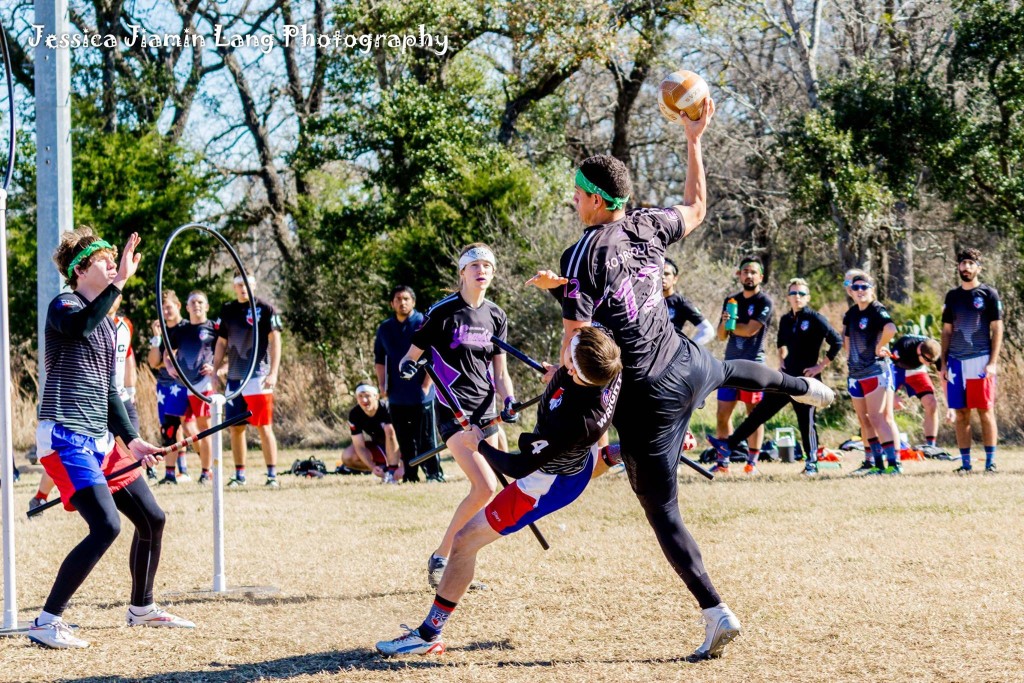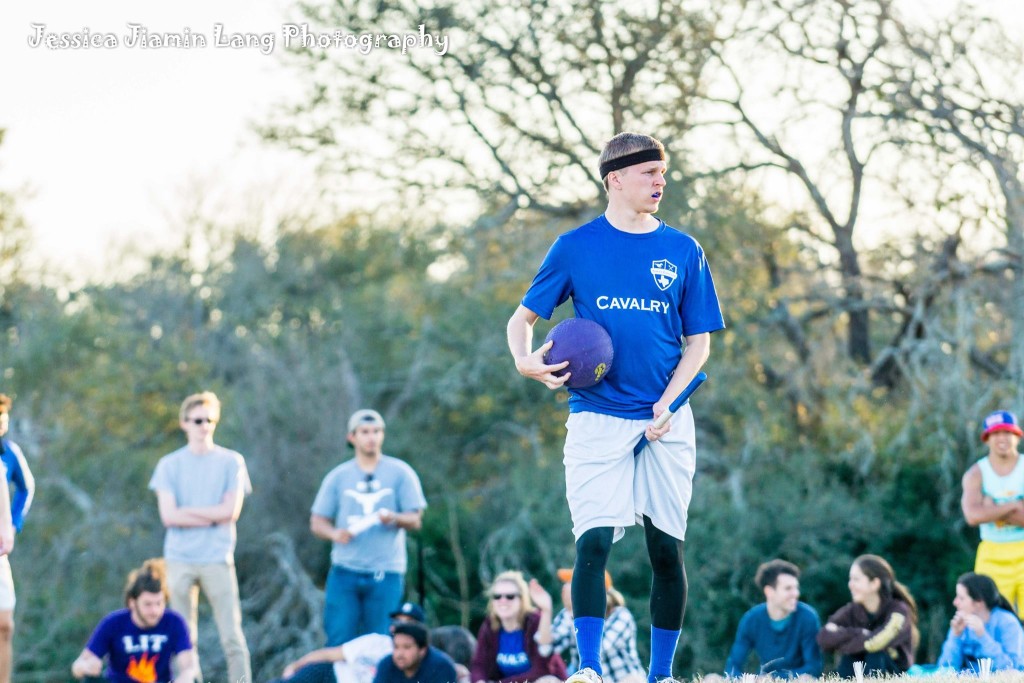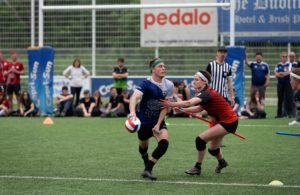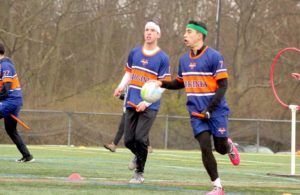- Rule, Britannia, no more?
- Unpopular Opinions: US Quadball Cup 2023
- Proven Contenders: University of Virginia
- Proven Contenders: Rutgers University
- Proven Contenders: University of Michigan
- Proven Contenders: Creighton University
- Different Perspectives: A Look Inside USA Ultimate
- Antwerp QC, Much of Belgian Core, Leaves Competitive Quidditch
Water Cooler: Southwest Storylines
- By Ethan Sturm
- Updated: February 19, 2016

Credit: Madison Seale, Nick May, Abbi Pittman
The most relevant USQ regular season tournament–the Southwest Regional Championship–is finally upon us.
Don’t believe me? You think Bat City Showcase was more impactful?
Well, consider this: last season, almost every team that attended the Southwest Regional Championship qualified for World Cup VII. Despite those unsurprising results, the aftermath was anything but predictable. In the weeks that followed actions were taken in response to regional-related mishaps including the firing of the Southwest Regional Director due to a mid-weekend Facebook argument and a last-second World Cup rules clarifications due to a regional semifinal injury. On the brighter side, we saw the first group of players to earn both a regional championship and a World Cup title in their career and the reestablishment of Lone Star Quidditch Club as the consensus number one team in the country, a spot they would hold right up until a University of Texas grab that resulted in a World Cup trophy.
So what can we expect from the Southwest Regional Championship this time around? Let’s first look at recent rankings and results.
For the first time in over three years, a Southwest team doesn’t sit at the top of our rankings, with Quidditch Club Boston ripping away the spot. Not only that, but Boston, the Lost Boys Quidditch Club and the Los Angeles Gambits went a combined 4-2 against Texas Cavalry and Lone Star at Bat City, a tournament played in the Southwest’s own backyard. Then there’s Texas State University, which put up a pair of meek performances at Brooms on the Brazos and Alamo Cup, most notably falling to the new-and-improved Texas A&M University in the latter’s finals.
All of these changes and uncertainties set up an increasingly tense backdrop for an already intense tournament, offering bids to only nine of the 20 attending teams. While the region boasts some of the best squads in the sport, only a select few will make it to South Carolina. And if you expect the seven teams currently in our Top 20 to qualify, that only leaves two more spots. With so much to watch, let’s focus on some of the major themes running through this weekend’s qualifier.
In Search of an Identity
The Southwest has always been known as the most physical and athletic region. When Texas won World Cup VI, it was because the team played offense in a way never seen before. Then, it won World Cup VII by being tougher than anyone had seen before. World Cup VIII was more of the same.
But physicality and athleticism no longer make up an identity for an elite team–they’re just the prerequisites. Cities like Boston and Los Angeles have bridged the gap by consolidating enough athleticism into their community teams to reach a level playing field with the Southwest’s best. And at Bat City, Lone Star didn’t seem ready to accept it. While Boston recognized the high levels of athleticism and adjusted, constantly gang-tackling other teams’ star players and daring someone else to beat them, Lone Star continued to attempt to win 1-on-1 matchups defensively all-day long. The best example may have been Boston and Lone Star’s games against the Gambits: Boston committed endless resources to getting the ball out of Tony Rodriguez’s hands, while Lone Star kept throwing its defenders at Rodriguez one at a time, allowing Gambits’ star player to go to town on them.

Credit: Jessica Jiamin Lang
But it’s not just Lone Star that is struggling to adjust. In Texas State’s pool play game against Texas A&M at Alamo Cup, it took the Bobcats almost the entire seeker floor to finally score a goal. The reason wasn’t poor execution or a lack of bludger control, but instead constant failures in no-bludger situations. Texas State would repeatedly try to run through the entire defense instead of taking the mid-range shot or passing to an open teammate, because that’s what has always worked in the past. But in today’s game, more often than not, that strategy ends up with the quaffle at the bottom of a multi-player pile up. And that is exactly what happened that game.
The region is also redefining what it means to be a Southwest beater, with top teams currently interweaving various beating styles While many beaters still rely on the tried and true physical style made popular by Ryan Peavler and used by other top contributors like Eric Willroth, Augustine Monroe has brought a Northeast-beating style into the region, while Texas A&M’s raw talent Harris Coleman is still defining himself and Texas State’s Jackson Johnson continues to innovate his own take on the position. Will we see more styles integrated into beater play this weekend or will one rise above the rest, propelling specific teams to massive advantages? This tournament feels like a battle not of rosters, but strategy. The region is a tornado of innovations right now, and whichever team can break from the quagmire with new answers for old problems and define itself around them will have a massive step up come Sunday afternoon.
The Community Team Debate
Those who oppose the idea of a college-community split scored a decisive victory this past weekend at South Regionals, as Florida’s Finest–thought to be the region’s top team–not only failed to take the title, but failed to qualify at all. Even so, Southwest Regionals and South Regionals are in two different worlds of national attention, and any slip-ups from the community teams this weekend could end up having much larger implications.
Lone Star and Texas Cavalry enter the weekend as prohibitive co-favorites, but with a sizable number of college squads knocking on the door. The wall between the two demographics became even more firm with the spring tournament schedule: the college teams headed to Brooms on the Brazos and Alamo Cup, while the community teams solely played at Bat City. Then our rankings almost arbitrarily dropped all college teams below the “Bat City Five”–I’m still waiting for the noir poster–adding even more insult.
Unfortunately for those pulling for a college champion, history tells us that the Southwest Regional Championship is not a time for the status quo to be upended. The last two iterations were taken by Texas A&M and Lone Star, respectively, which entered the two tournaments with a combined 42-1 record and with 17-of-19 first-place votes in our poll. They were both expected to win and proceeded to do so without playing a single snitch-range game.
However, this year’s co-favorites are not the infallible beasts the past two champions have been. Lone Star has suffered four losses to four different teams–including two in attendance this weekend–and is just starting to show signs of a competent beating game. The team will also have to deal with the absence of star point defender Simon Arends. Cavalry, meanwhile, soared up the rankings with the addition of Ryan Peavler, Lauren McGarrah and Richard Kemp as transfers from Gulf Coast Gumbeaux. But with Peavler (though listed on the roster) and McGarrah both out injured, and Kemp not in attendance, Cavalry could have more of the look of a tier-two team in the region this weekend.

Credit: Jessica Jiamin Lang
Even if Lone Star and Cavalry can hold serve and meet in the finals, the storylines could be just as impactful if bubble teams like Gumbeaux and Tribe fail to qualify all together. At that point, the narrative becomes, “Sure, a couple community teams are really good, but the rest clearly need to remain at the college teams’ level.” But if community sides absorb nearly half of the region’s bids, including the entire finals matchup, the arguments for a split are bound to flare up again, especially with the likelihood a community team final waiting for us next weekend at the West Regional Championship, as well.
Calling in the Cavalry
As I alluded to in the last section, Cavalry is one of the most interesting stories of this weekend. Even after scoring a win over Lone Star, the team failed to progress above fourth in the nation. The series of transfers turned it into a US Quidditch Cup 9 contender almost overnight, but then injuries brought it right back to square one.
So where does the team sit right now? That may come down t to what Augustine Monroe brings to the pitch this weekend. Monroe and Peavler have enjoyed a thunder-and-lightning combination for a few months, playing contrasting styles that constantly kept the opposition on edge. With Peavler out toward the end of Bat City, Monroe had to play almost every minute at beater in the team’s loss to the Lost Boys, limiting the squad’s strategic fluidity. As the Southwest team most reliant on out-planning the opposition, that could be seen as a major hurdle. Whether the team builds around Monroe or if Monroe shifts toward Peavler’s playstyle remains to be seen.
Cole Travis was another key player whose disappointing performance contributed to Cavalry’s loss to the Lost Boys. Travis spent most of the first semester as the clear Breakout Player of the Year, but it’s a lot easier to get the better of people when they don’t know what to expect from you. As the primary ball carrier on a top five team for almost half a year now, that’s not a luxury Travis will get anymore. If he can handle the attention, Cavalry should be one of the scariest teams of the weekend, but if he can’t, Freddy Salinas and Marty Bermudez will need to pick up a lot of slack.
The fate of this team may seem like a total crapshoot, but let’s not forget that its core consists of three-time World Cup Champions that have never won a Southwest Regional Championship. Don’t be surprised to see Cavalry suffer a disappointing weekend, learn a lot and make a real run at the title in April.
Related Posts
About Ethan Sturm
Ethan is the co-founder and former managerial editor and chief correspondent of The Eighth Man. When not talking quidditch, which is rare, he can be found drilling people's teeth and spending time with his elusive wife. He's also the worst.



